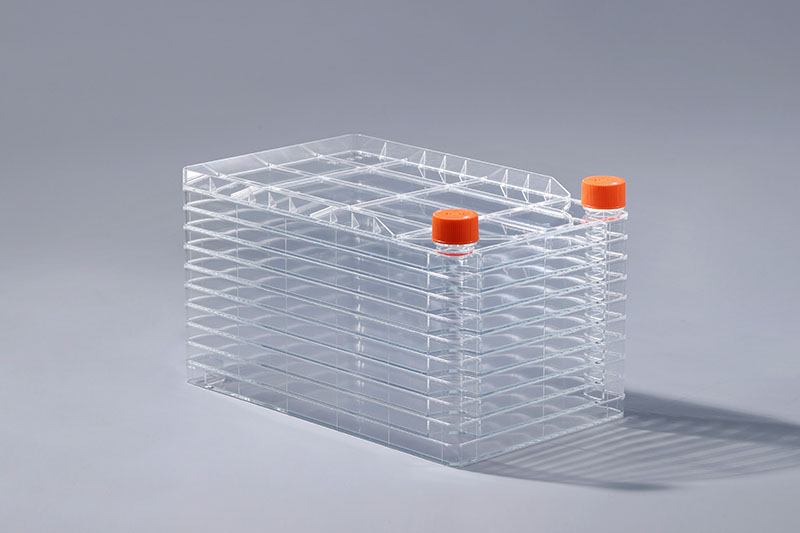เป็นวัสดุสิ้นเปลืองที่ใช้กันทั่วไปในการเพาะเลี้ยงเซลล์ขนาดใหญ่ โครงสร้างประกอบด้วยหนึ่งหรือหลายชั้น และชั้นบนสุดมีพอร์ตการกําเนิดสองพอร์ต กระบวนการใดที่ใช้ในการผลิตโครงสร้างที่ซับซ้อนเช่นนี้?กระบวนการฉีดขึ้นรูปที่โรงงานเซลล์นำมาใช้ส่วนใหญ่ประกอบด้วยขั้นตอนต่อไปนี้:cell factory
①กระบวนการก่อนขึ้นรูป:
กระบวนการก่อนการขึ้นรูป คือ วัสดุพลาสติกถูกให้ความร้อน ขนส่ง อัด เฉือน ผสมและทำให้เป็นเนื้อเดียวกันในถังเพื่อเปลี่ยนวัสดุจากสถานะแก้วเป็นสถานะของเหลวหนืด เพื่อให้เป็นไปตามข้อกำหนดของการฉีดขึ้นรูป
②กระบวนการบรรจุการฉีด:
ในขั้นตอนการเติมการฉีด สกรูจะฉีดสารหลอมในห้องเก็บของเข้าไปในโพรงผ่านหัวฉีด ตัววิ่งแม่พิมพ์ และประตูที่อยู่ใต้แรงขับของกระบอกฉีด
③ กระบวนการบีบอัดและอัด:
ดำเนินการฉีดต่อเพื่อเติมปริมาตรที่ว่างโดยชิ้นส่วนเนื่องจากการหดตัว
④กระบวนการทำความเย็นและการตั้งค่า:
หลังจากกดค้างไว้แล้ว ประตูจะถูกแช่แข็ง บทความผ่านช่วงเวลาของการระบายความร้อนและการตั้งค่า
⑤ กระบวนการดีดออกและหยิบขึ้นมา:
หลังจากที่ผลิตภัณฑ์ถูกทำให้เย็นลงเป็นระยะเวลาหนึ่ง ผลิตภัณฑ์จะมีความแข็งแกร่งและความแข็งแกร่งระดับหนึ่ง ชิ้นส่วนถูกขับออกจากแม่พิมพ์ฉีดโดยหมุดอีเจ็คเตอร์ของแม่พิมพ์
ช่องเติมและส่วนหลักของชั้นบนสุดของโรงงานผลิตเซลล์ถูกฉีดขึ้นรูปแบบผสมผสาน กระบวนการนี้สามารถมั่นใจได้ว่าผลิตภัณฑ์มีประสิทธิภาพการปิดผนึกและความแข็งแรงที่ดี ข้างต้นเป็นขั้นตอนการผลิตเซลล์ของโรงงาน นอกจากนี้ กระบวนการฉีดขึ้นรูปยังเหมาะสำหรับการแปรรูปโพลิโอเลฟิน โพลิเอไมด์ พอลิออกซีเมทิลีน โพลีคาร์บอเนต และวัสดุอื่นๆ
The filling port and the main body of the top layer of the cell factory are integrally injection-molded. This process can ensure that the product has better sealing performance and good strength. The above is the production process of the cell factory. In addition, the injection molding process is also suitable for the processing of polyolefin, polyamide, polyoxymethylene, polycarbonate and other materials.
The FAI climbed 5.9 percent year-on-year in the first 11 months of 2018, quickening from the 5.7-percent growth in Jan-Oct, the National Bureau of Statistics (NBS) said Friday in an online statement.
The key indicator of investment, dubbed a major growth driver, hit the bottom in August and has since started to rebound steadily.
In the face of emerging economic challenges home and abroad, China has stepped up efforts to stabilize investment, in particular rolling out measures to motivate private investors and channel funds into infrastructure.
Friday's data showed private investment, accounting for more than 60 percent of the total FAI, expanded by a brisk 8.7 percent.
NBS spokesperson Mao Shengyong said funds into weak economic links registered rapid increases as investment in environmental protection and agriculture jumped 42 percent and 12.5 percent respectively, much faster than the average.
In breakdown, investment in high-tech and equipment manufacturing remained vigorous with 16.1-percent and 11.6-percent increases respectively in the first 11 months. Infrastructure investment gained 3.7 percent, staying flat. Investment in property development rose 9.7 percent, also unchanged.
 English
English



















































